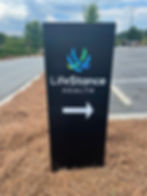How Directional Signs Can Improve Navigation in Public Spaces
- SignsDesignedofCharlotte
- Aug 15
- 4 min read
Navigating public spaces can often be confusing and frustrating. Whether you are visiting a large park, a hospital, a shopping mall, or a university campus, finding your way quickly and efficiently is essential. Directional signs play a crucial role in guiding people through these environments. They help reduce stress, save time, and improve the overall experience of visitors. This article explores how directional signs can improve navigation in public spaces, offering practical insights and examples.
The Importance of Directional Signs in Public Spaces
Directional signs are more than just arrows on a wall or posts. They are carefully designed tools that communicate essential information to help people find their destinations. Without clear directional signs, visitors may get lost, miss appointments, or feel overwhelmed.
Key benefits of directional signs include:
Enhancing visitor experience: Clear signs reduce confusion and make navigation intuitive.
Improving safety: Proper signage can guide people away from restricted or hazardous areas.
Increasing efficiency: Visitors spend less time searching for locations, which is especially important in busy places like airports or hospitals.
Supporting accessibility: Well-designed signs can assist people with disabilities by providing clear, readable information.
For example, in a large hospital, directional signs help patients and visitors find departments, restrooms, and emergency exits quickly. In parks, signs guide visitors to trails, picnic areas, and parking lots, ensuring a smooth visit.

How Directional Signs Enhance Wayfinding
Directional signs are a fundamental part of wayfinding - the process of navigating from one point to another. Effective wayfinding relies on clear, consistent, and strategically placed signs.
Characteristics of Effective Directional Signs
Visibility: Signs should be easy to spot from a distance.
Legibility: Text and symbols must be clear and readable.
Consistency: Use uniform colors, fonts, and symbols throughout the space.
Placement: Signs should be located at decision points such as intersections or entrances.
Simplicity: Avoid clutter; keep messages concise.
For instance, in a shopping mall, directional signs placed at every corridor intersection help shoppers find stores, restrooms, and exits without confusion. The use of universal symbols, such as a shopping cart for stores or a knife and fork for food courts, enhances understanding for all visitors.
Practical Recommendations for Implementing Directional Signs
Conduct a thorough site analysis to identify key decision points.
Use contrasting colors to improve visibility.
Include arrows and distance information to clarify directions.
Regularly maintain and update signs to ensure accuracy.
Incorporating these practices can significantly improve navigation and visitor satisfaction.
What are the four types of wayfinding signage?
Wayfinding signage can be categorized into four main types, each serving a specific purpose in guiding people through public spaces:
Identification Signs
These signs identify a place or facility, such as building names, room numbers, or landmarks. They help visitors confirm their location.
Directional Signs
These provide guidance on how to reach a destination. They often include arrows and distance markers.
Informational Signs
These offer additional details about a location, such as hours of operation, rules, or historical facts.
Regulatory Signs
These communicate rules and regulations, such as no smoking areas or restricted access zones.
Understanding these types helps in designing a comprehensive signage system that covers all aspects of navigation and information.

Examples of Directional Signs in Different Public Spaces
Directional signs vary depending on the type of public space and its specific needs. Here are some examples:
Parks and Recreational Areas
Trail markers indicating distance and difficulty.
Signs pointing to restrooms, picnic areas, and parking.
Maps at entrances showing the layout.
Transportation Hubs
Signs directing passengers to gates, ticket counters, and baggage claim.
Clear exit and emergency route signs.
Multilingual signs for international travelers.
Educational Institutions
Building identification signs.
Directional signs to classrooms, libraries, and cafeterias.
Event-specific signage during open days or conferences.
Healthcare Facilities
Signs guiding patients to departments, labs, and pharmacies.
Emergency exit and evacuation route signs.
Accessibility signs for wheelchair users.
Each example highlights the importance of tailored directional signage solutions to meet the unique challenges of different environments.
How to Choose the Right Directional Signage Solutions
Selecting the right signage involves considering several factors to ensure effectiveness and durability.
Material and Durability
Outdoor signs should be weather-resistant.
Indoor signs can use lighter materials but must withstand wear and tear.
Design and Branding
Signs should align with the overall aesthetic of the space.
Use colors and fonts consistent with branding guidelines.
Accessibility
Include braille or tactile elements for visually impaired visitors.
Ensure signs are placed at accessible heights.
Technology Integration
Digital signs can provide real-time updates.
Interactive kiosks can enhance user engagement.
For those looking for professional options, directional signage solutions offer a variety of customizable signs that can be tailored to specific needs and environments.
Enhancing Visitor Experience Through Effective Signage
Well-designed directional signs contribute significantly to a positive visitor experience. They reduce anxiety, save time, and make spaces more welcoming.
Tips for Improving Visitor Experience
Use clear and simple language.
Incorporate universal symbols.
Provide maps and directories at key points.
Regularly review and update signage based on visitor feedback.
By focusing on these elements, public spaces can become more user-friendly and accessible to everyone.
Directional signs are essential tools that improve navigation and enhance the overall experience in public spaces. By understanding their importance, types, and best practices, organizations can create environments that are easy to navigate, safe, and welcoming. Whether in parks, hospitals, or educational institutions, investing in quality directional signage solutions is a step toward better public space management.































